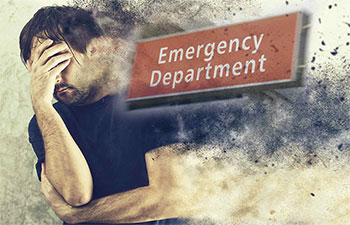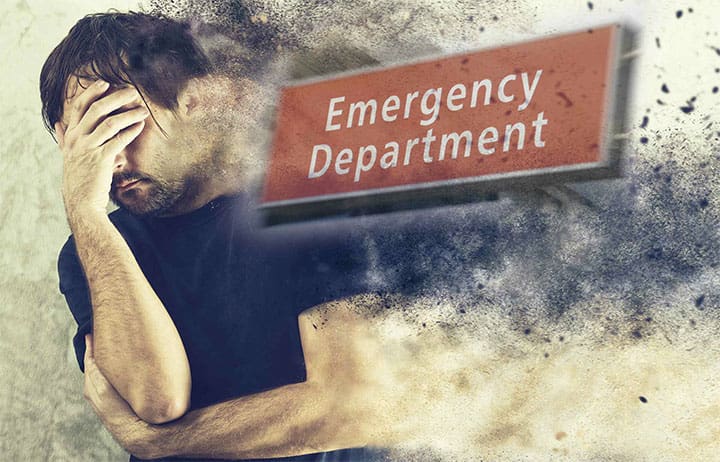Safety and continuity are key to successful care.
By Jessica L. Dzubak, RN
Takeaways:
- The most important consideration when caring for this special population is ensuring, first and foremost, staff and patient safety.
- Both psychiatric patients and the staff caring for them have rights and deserve a safe and respectful environment.
- A collaborative team approach with appropriately trained staff is recommended for optimal care.
 With nearly one in five Americans (approximately 10 million people) suffering from a mental illness, emergency departments (EDs) are facing an unprecedented challenge. Psychiatric admissions are at an all-time high, and inpatient beds for patients with psychiatric disorders are in high demand. Delivering optimal care to those with mental health emergencies is a complex challenge that requires evidence-based, streamlined protocols and policies. Staff also should be provided with the education and resources they need to feel empowered to care for these patients.
With nearly one in five Americans (approximately 10 million people) suffering from a mental illness, emergency departments (EDs) are facing an unprecedented challenge. Psychiatric admissions are at an all-time high, and inpatient beds for patients with psychiatric disorders are in high demand. Delivering optimal care to those with mental health emergencies is a complex challenge that requires evidence-based, streamlined protocols and policies. Staff also should be provided with the education and resources they need to feel empowered to care for these patients.
Standardized plans of care that prioritize safety, continuity, and quality should be the focus of mental health care in the ED, whether you’re in a 10-bed ED or a 100-bed trauma center.
Where to begin—Triage and medical clearance
Psychiatric emergency care begins with accurate, timely triage using the emergency severity index, an algorithm that stratifies patients into groups, from 1 (most urgent) to 5 (least urgent). During this process, the ED nurse combines both clinical judgment and emotional connections to assess the patient’s situation to identify possible mental health issues. Hospitals should have policies in place for patients who have psychiatric signs and symptoms. Policies include continuous monitoring, risk assessments for domestic violence and suicide, and precautions to prevent elopement—wandering away from the facility.
Know that many medical conditions, including encephalopathy, infections, and medications, can cause reversible psychiatric symptoms. To rule out medical causes, proper clinical assessments, physical exams, and pertinent laboratory work should be completed. However, these evaluations take time, so you should be familiar with your hospital’s policies on medical holds. Typically, physicians can place patients on a medical hold to prevent them from leaving the hospital until medical tests have been completed to rule out organic causes of their symptoms. This differs from an application for emergency admission, referred to in some states as a “pink slip.” This legal hold can be placed by physicians or law-enforcement officers if the patient is believed to be at substantial risk of physically harming him- or herself. It’s legally binding and can be overturned only by a physician or judge.
Safety first
Patients may feel a loss of control when they come into the ED, which can lead to agitation, so make them a part of their care plan whenever possible. The Emergency Nurses Association (ENA) recommends treating patient agitation as if it’s “the chest pain of behavioral emergencies.” Promptly share your assessment of rapidly escalating situations or increasing agitation with the treatment team.
Take agitated patients out of public spaces and to a secure room with trained emergency staff. The room should provide a safe environment for the patient to help de-escalate the situation, with nothing that might be used as a weapon or increase the patient’s agitation. A collaborative approach to de-escalation that includes the patient is recommended. For example, when possible, give patients choices so they have a sense of security and control. Respect personal space and speak calmly.
The ED team should try every measure available to avoid resorting to physical restraints. However, if restraints are required to ensure patient and staff safety, follow your organization’s guidelines, including timeframes for reassessment and specific nursing documentation.
Behavioral health emergencies can be frightening and overwhelming for both patients and staff. Developing a standard for safety protects everyone. (See Steps to safety.)
Steps for safety
| The following steps can help ensure patient and staff safety when working with patients with psychiatric conditions.
• Training—Staff should receive training and education in crisis intervention and safe de-escalation techniques. |
Barriers to providing care
Fear, lack of resources, and inadequate training are all reasons ED staff give for their apprehension about caring for patients with psychiatric conditions. For example, some staff report being abused by patients, even to the point of physical injury, which makes them wary in future encounters. However, with proper training in crisis intervention and de-escalation techniques, staff will gain confidence and feel empowered to care for patients with mental health emergencies.
Another barrier to providing adequate care is ED overcrowding because of the unavailability of inpatient psychiatric beds and the opioid epidemic. Overcrowding stretches staff too thin and can affect the availability of resources. Another contributing factor to overcrowding is that some people who have nowhere else to turn view the ED as a refuge where they can obtain basic needs, such as food and water.
For patients who frequent EDs, especially with changing or vague psychiatric complaints, nurses and clinicians need to determine why. Sometimes patients have reasons other than needing medical or psychiatric care for coming to the ED, such as the need for food or a warm bed. When these needs or problems are identified, the care team can address them and provide the resources the patients really need, such as referral to a social worker.
Improvement through continuity
Many ED nurses agree that standardized care and continuity will improve psychiatric care in the acute emergency setting, prevent patients from falling through the cracks, and decrease misuse of the ED. Patients with psychiatric emergencies need consistency, routines, and clear boundaries, and the standard of care should not change from person to person or shift to shift.
Although some hospitals have streamlined protocols for rapidly assessing at-risk patients and determining appropriate disposition, room for improvement exists. Patients, particularly those who frequent EDs or perhaps use multiple EDs, should receive the same care wherever they go. For example, urine toxicology screens and medical clearance processes should be consistent across the board, based on current evidence-based practice. (See Quality care in mental health emergencies.)
Quality care in mental health emergencies
| These strategies will help you ensure optimal outcomes for patients who come to the emergency department (ED) with a mental health emergency. • Complete continuing education to improve your comfort level in caring for psychiatric patients in the ED. • Use de-escalation techniques with agitated patients. Use restraints only as a last resort and follow requirements from your organization and the Centers for Medicare and Medicaid Services. • Don’t assume a new problem or symptom is related to the psychiatric condition. Check for a medical cause first. • Encourage a supportive person to stay with the patient, and limit visitors who are creating tension. • Give patients choices whenever possible. Control is taken away from patients in this setting; giving choices, however small, can establish trust and respect. • Continue psychiatric medications unless there’s a medical reason not to. • Access resources such as the behavioral health section of the Emergency Nurses Association website. |
Other areas that require continuity include promptly verifying medications patients take at home; many psychiatric medications can cause adverse reactions if they’re abruptly stopped. ED staff also should obtain information about substance misuse to monitor for withdrawal, but reassure patients that the goal is to provide the best, safest care for them, and that legal repercussions of substance abuse are not a concern.
Because care of the acute psychiatric patient is intricate and delicate, the ENA recommends having trained psychiatric staff available in the ED. Most EDs have social work counselors on site or on call, but they don’t have dedicated psychiatric nursing staff.
Dignity and respect
Not all patients with a psychiatric emergency who arrive in the ED are open to receiving help, and some may pose a safety threat to themselves or others. Regardless of how they come into your care, they deserve dignity and respect. Degrading these patients or withholding things like bathroom breaks is never acceptable. Consistency, continuity, and communication from everyone on the care team can help ensure patients get the help they need.
Jessica L. Dzubak is an ED staff nurse at OhioHealth in Columbus.
Selected references
Emergency Nurses Association. ENA topic brief: Care of behavioral health patients in the emergency department. December 2014.
eEmergency Nurses Association. Care of the psychiatric patient in the emergency department. 2013.
Lenehan GP. Agitation—The chest pain of behavioral emergencies. ENA Connection. March 2010.
Normandin PA. Behavioral health emergencies. J Emerg Nurs. 2016;42(1):81-4.
National Alliance on Mental Illness. Mental health by the numbers.
Richmond JS, Berlin JS, Fishkind AB, et al. Verbal de-escalation of the agitated patient: Consensus statement of the American Association for Emergency Psychiatry Project BETA de-escalation workgroup. West J Emerg Med. 2012;13(1):17-25.
ant11-ED Mental Health-1030


















